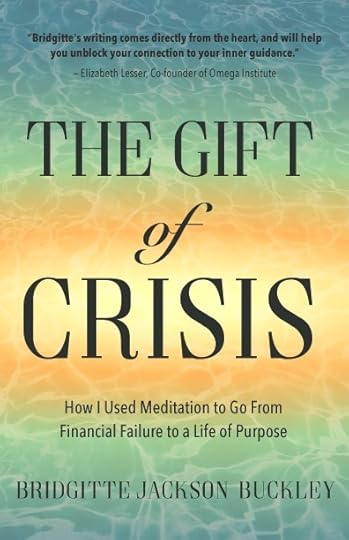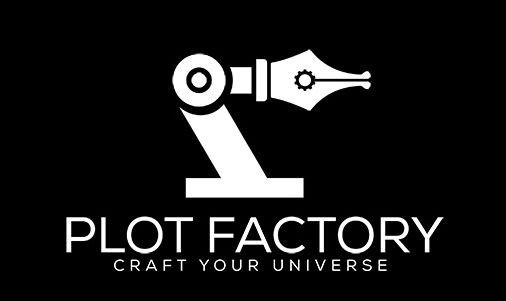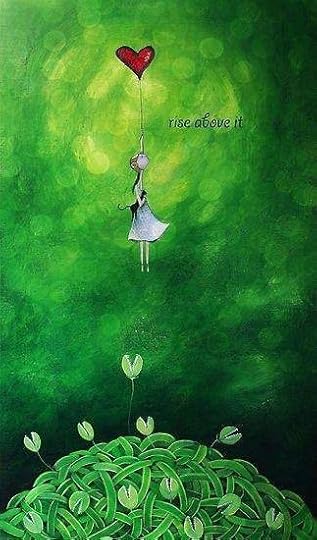Bridgitte Jackson-Buckley's Blog, page 6
May 24, 2018
Finding Purpose During Financial Crisis

“When the heart is ready for a fresh beginning, unforeseen things can emerge. And in a sense, this is exactly what a beginning does. It is an opening for surprises. Surrounding the intention and the act of beginning, there are always exciting possibilities. Such beginnings have their own mind, and they invite and unveil new gifts and arrivals in one’s life. Beginnings are new horizons that want to be seen; they are not regressions or repetitions. Somehow they win clearance and become fiercely free of the grip of the past. What is the new horizon in you that wants to be seen?” -John O’Donohue
I was raised in a home where we faithfully attended a Baptist church. As a child, I spent many Sunday afternoons sitting on an uncomfortable wooden church pew, while listening to sermons about the strong possibility of me going to hell. At 12 years-old I even had a traditional water baptism. However, despite this religious background in place, at some point during the trying times of my adult life I moved away from faith into fear and scarcity. I can recall having made some major decisions rooted in fear, poverty mentality and heavily disguised self-doubt, and because of this I did not always honor what was in my heart.
The more I let fear take the lead in how to direct my life, the closer I moved toward crisis.
After years of prolonged financial problems, I had to accept that I could no longer dismiss the repetition of these problems in my life. The crises in my life eventually served as catalysts for me to understand I needed to make different choices to engage higher perspectives. In reading self-help and personal growth books, I began to understand when there is a reoccurring problem, such as the financial hardship we experienced, the underlying higher messages want to be revealed. They will make a continuous unyielding effort to get our attention through repeated states of crisis. The opportunity that lies within perpetual crisis is, you have to be willing to look closely and identify the underlying patterns and message in what is happening around you.
The prolonged crisis, along with the hundreds of books I read and uplifting talks and workshops I attended, encouraged me to be still and be quiet in order to allow the deeper messages to make themselves known. It was from this humble beginning that I actively began to participate in my personal unfoldment by means of what would become my saving grace, going within and seeking clarity through meditation and prayer.
Throughout the turmoil, it wasn’t easy. With continual highs and lows, I grew tired of listening to myself constantly whine and complain. Although I was scared and wanted answers, I didn’t want to continue to discuss our situation with family and friends. With no money to pay for therapy or counseling, it seemed the only place left for me to go was within.
So I did.
During my meditations, in addition to periods of silence after prayer, I began to ask questions to solicit clarity and guidance into my awareness. The more I posed questions during a meditative state, I began to notice answers would indeed come into my awareness. However, as soon as the meditation session was over, I would forget what guidance came into my awareness. The only way to remember would be for me to write it down. It was at that time I decided to bring a large pad and pen to my meditation and prayer sessions. At the start of the meditation, I would first pray. I then would move into a period of sustained silence. After getting comfortable in twenty minutes of complete silence, I was much more relaxed and whatever thoughts that continued to try to hover would begin fade.
With my eyes still closed I would then say the following:
“I call upon my Higher Self to join me in my meditation. During this meditation, I ask that you protect me from any and all vibrations, energies, frequencies and communications in all directions of time past, present and future that are not of love, light and the highest good. Please let this communication be clear. Let the answers be communicated to me in a way that is easy for me to understand. Please let me feel your loving energy when you are ready to begin. I thank you in advance for your presence.”
For more than one year, I sat down in a meditative state and asked questions to help me mentally and emotionally navigate the difficult and uncertain times I faced. The guidance I recorded helped me to move through some of the most difficult and unsettling times with comforting reassurance that I was deeply loved, there was no need to be afraid and that I was not alone. The guidance I received, however, were not the answers I wanted. My posed questions and concerns were continual attempts to address the immediate unfavorable conditions that surrounded me. The guidance during my meditation, however, provided the larger context of what was happening in my life and the higher messages that sought to make themselves known.
So many times prior to understanding, when I felt anxiety surrounding the outcome of a situation, I utilized my spiritual practice for a “save me please” answer. I wanted someone, something, anything to tell me what to do, to whom I should speak and what I should say. For a long period of time, I wanted to be rescued. I didn’t want to do the “heavy lifting” of really looking at what was underneath. In the beginning, when I began to ask for guidance those times were no different. I didn’t want anything vague. I wanted the final answer in the form of a deeply fulfilling (and immediate) job. However, that’s not how this works. That’s not how any of this works.
One aspect that is important to understand is that for years fear dominated my responses, my choices, my reactions, my conversation, and movement throughout my life. I was consistently afraid that some event would occur that we would not be able to financially handle. And eventually it did. For a prolonged period of time we could to not afford to live anywhere. We could not pay our bills, and it was an unyielding struggle that took a toll on every aspect of our life. Before establishing a consistent mediation practice, I constantly felt threatened by a looming financial disaster, and my nerves “lived” in fight-or-flight mode from the endless anxiety I created.
In the midst of this silent struggle, I turned within to be able to make it through each day.
I knew that I could either continue to do things as I always have, or take a chance of actually trusting my intuition and absorbing what the moment was trying to teach me.
Life is not always linear, pretty and clear.
Sometimes you have to step outside of the box, especially when you realize you’re being pulled out of the box. With this in mind, I continued to meditate. Meditation grew to become the most practical, accessible and effective way I found to calm myself of the anxiety-ridden thoughts that propelled me.
Let’s be clear, meditation did not immediately remove any situation from my life. That’s not what it does. Although mediation can be a powerful tool for personal growth, it is not a quick fix. What it did was help me to establish and strengthen my practice of meditation and prayer, as a way to move through the conundrum of situational difficulties with greater ease, trust and a sense of growing empowerment. Considering there were deeply held unconscious beliefs that unknowingly contributing to the problems in my life, meditation helped me to bring these unconscious beliefs to the surface to be consciously addressed and released.
Here are the three levels of the mind that influence our lives:
The conscious mind is everything you are aware of and thinking about. It includes sensations, perceptions, memories, feeling and fantasies inside of our current awareness.The subconscious mind consists of accessible information you can become aware once your direct your attention to it; memory recall.The unconscious mind is a reservoir of unconscious beliefs, patterns, and subjective maps of reality that automatically reacts to situations according to its stored behavior. It includes feelings, thoughts, urges, and memories that are outside of our conscious awareness where information is hidden and stored. Most of these contents are unacceptable or unpleasant, such as feelings of pain, anxiety, or conflict.Within each of us there is also a higher part that goes beyond our conscious awareness. This Higher Self always has access to and communicates with a higher, more expansive and intelligent Divine Consciousness that some refer to as God, Goddess, the I AM Presence or something else. The Higher Self is the highest expression of your individual connection with the Divine Consciousness. It is greater than our conscious everyday self. It is part of you, yet more than you. It is in and of itself a part of the Divine Consciousness. Within the practice of quieting the mind and connecting with our Higher Self, we can access unconscious information from the highest part of ourselves that is out of our conscious awareness.
Meditation is the “doorway” through which I was able to quiet my mind and access unconscious information from my Higher Self. Through meditation, higher information can be brought into our conscious awareness to identify the best course of action towards the highest outcome.
Bridgitte Jackson-Buckley writes about topics related to spirituality and personal growth and is based in Los Angeles. Her first book The Gift of Crisis: How I Used Meditation to Go From Financial Failure to a Life of Purpose will be released October 15, 2018. It is now available for pre-order .


May 13, 2018
May 12, 2018
Mothering
 Photo Credit: Jeswin Thomas
Photo Credit: Jeswin Thomas“I used to think of mothering in simplistic terms: one who raises her children. But I now see this as limited. A mother is beyond one who bears, raises or adopts a child. She is one who gives. Period. She is one who gives life, is connected to life and is one with life. In this sense every man, woman and being who gives is a mother.”
To give of oneself is to be generous with one’s time, concern, love and attention, which is no small thing.
“Let this Mother’s Day be one where we honor each and every being on earth the way we honor the Mother that IS LIFE.”
Happy Mother’s Day to the traditional and non-traditional mothers of the world.

April 6, 2018
Great idea!
Great idea! With collaborations the possibilities are huge. It would be great to connect with other writers interested in genre specific projects.

March 30, 2018
How to Make Book Signing Events More Engaging
 Photo by freddie marriage
Photo by freddie marriageA few weeks ago there was book signing event I was incredibly excited to attend. The author recently published a beautifully illustrated informational book, and it was on social media the author would be on book tour at local bookstore. Happily, I put the date of the signing on my calendar, told the kids about it, and decided on my outfit beforehand. Again, I was totally excited to go.
The day of the event, I made preparations to arrive early. My normal modus operandi is to arrive 20 minutes before event start time, in hopes I will be lucky with last minute parking and seating. Not this time. I made sure we left home with ample time to deal with L.A. traffic and L.A. parking.
When we arrived at the bookstore, it was packed! There were so many people standing around, looking for seats and buying the author’s book. There were women, men, and children of various ages and ethnicity, the bookstore owners, and friends and family of the author. It was so exciting! There was high energy, anticipation, and good chatter amongst those of us simply waiting to see her, the author.
The author sat in corner of the bookstore behind the signing table, and watched patrons buy her book and fill seats. Once all the seats were taken, adults stood in corners and children squeezed in between chairs on the floor. When the bookstore owner walked out in front of the audience to introduce the author, you could have heard a pin drop. Silent anticipation filled the space. We were waiting for her. I was waiting for her. The bookstore owner eloquently introduced the author.
With my shoes off, one copy of her book on my lap, my son seated cross-legged on the floor and my daughter leaning against the wall, I watched her move to the front of the audience.
‘Speak! Tell us! Tell us! Give us the backstory! Tell us how you decided upon this creative project! What was your inspiration? Process? Moments of doubt? Unexpected creative surprises?! Speak!’ I thought.
And so it began!
The author stepped in front of the audience and we applauded. She was delighted to see so many diverse faces in support of the book. So were we! She read a few passages from the book (very nice!), took three questions (all that were asked), including one from me, did a sample drawing illustration of how she created the figures in the book, and…30 minutes later, that was it.
Wait.
What about everything else?
I wanted to know so much more about…I don’t know…whatever else I didn’t know!
It’s an incredible undertaking to write a book, to illustrate a book, to market a book and to sell a book. There was a lot of effort made and work put in, on her part, to bring this project to completion. As book readers, one can only imagine; as book authors, we know how much work is involved. I thought she would talk about something behind the scenes, or tell us something we would like to know but didn’t know we wanted to know. I thought it would be engaging, informative, and at minimum exciting.
However, it was… anti-climactic.
Let’s be clear. I’m not saying I went to the signing merely to be entertained. Seeing that most in attendance already purchased the book, the notion of selling the book at the event was redundant. Most people held 2–3 copies of the book! And the line for the cash register was still long.
I couldn’t help but wonder what else could have been done at the book signing in lieu of what is usually done.
With so many in attendance this was another opportunity to be creative and fun, and maybe do something unique. This was the type of signing I would imagine all authors want, an event filled with people who (mostly) all have bought your book! So why not celebrate with the audience? Why not just have fun with the audience since you’ve met the goal?
While I am not a marketing expert, or event planner, I thought perhaps some of the following could have made the event more engaging:
1. An audience tally of their favorite chapter, scene, character, etc.
2. Tips for brilliant social media marketing (This is how the author got the book deal!).
3. A contest, or giveaway for the person who traveled the farthest distance to attend.
4. Have audience members read a favorite passage in the book and tell why it’s their favorite.
5. Spread the love. Talk about two of your favorite books (perhaps similar to your book) that audience members may not know about.
Despite my feeling that the event fell short, I have to say the author did not. She was gracious, kind and took the time to speak briefly with every single person who waited in line for her to sign the book. There was so much light in her eyes while she interacted with children and adults and thanked them for attending. There is nothing worse that meeting someone you admire and feel blown off by them. I can tell that each person who attended felt they were seen by author and given the gift of her time and attention.
It was apparent, the audience, regardless of the perspective in which they attended the signing, as a book reader or fellow author, was excited for her, and for the book.
The Writing Cooperative is brought to you by —

Plot Factory is an online story planner that lets writers plan, organize and create stories & fictional universes. Craft your universe. Forge rich characters. Create unique stories. Try it for free!

How to Make Book Signing Events More Engaging was originally published in The Writing Cooperative on Medium, where people are continuing the conversation by highlighting and responding to this story.
March 28, 2018
The Beginner’s Guide to Accepting Criticism
 Photo by Artem Kovalev
Photo by Artem KovalevHow do you deal with criticism? I think the first reaction for most of us is to defend ourselves, or worse yet to lash back.
And yet, while criticism can be taken as hurtful and demoralizing, it can also be viewed in a positive way: it is honesty, and it can spur us to do better. It’s an opportunity to improve.
Some time ago, I worked on a research project with a small group of co-workers. There were roughly seven of us who worked together on a daily basis. For the most part, we all got along well. There weren’t any major personality or professional issues.
Within the group there were two project managers, one of which I got along with really well. This project manager (PM) and I had (what I would refer to as) good chemistry: similar views and similar work habits. I liked working with him. He was also the manager with whom I would have my annual performance evaluation.
On the morning of the evaluation, the (good chemistry) project manager, the primary project investigator and I sat in the office meeting room. The PM would explain how I was evaluated in the performance of my duties. Although this PM would deliver the evaluation, the secondary project manager also had input which was (of course) included in the overall evaluation.
15 minutes into the meeting, the evaluation was going quite well. My performance consistently rated ‘Exceed Expectations.’ Then, the PM arrived at the ‘Taking Direction’ category and I noticed a change in his tone.
It got serious.
And like a perfectly timed clock, the door to the meeting room opened. The secondary project manager walked into the meeting room and sat down at the table. She was a slightly younger graduate student. She was the project manager and budgetary supervisor on the secondary project which corresponded with our main project.
As the budget technician for both the main and secondary project, I worked with her on project budgetary items. For the most part, she and I got along well. However, when we held meetings between the two of us, we conducted business in a polite but relatively cold manner.
Without having had a verbal discrepancy or disagreement, it was clear, on a rather quiet level, there was distance between us. When she made requests, I often responded with doing only what I was asked and nothing more. During office social events, our conversations were routinely forced and guarded.
We rarely sat at the same table for lunch.
The (good chemistry) PM said, “It has been noted there is resistance on your part with taking direction. This is an area that needs improvement.”
I looked away from him across the table at the secondary project manager. She looked at me.
Neither of us smiled.
1. Stop Your First Reaction
If your first reaction is to lash back at the person giving the criticism, or to become defensive, take a minute before reacting at all. Take a deep breath, and give it a little thought.
Personally, my initial reaction to criticism is normally to feel tense. However, I have also taught myself not to react right away. For example, I’ll let a critical statement sit in the “atmosphere” for a while before I respond. Or, if possible, I’ll spend time away from someone instead of saying something I’ll regret later.
That space allows me to give it more thought beyond my initial reaction. It allows logic to step in, past the emotion. I don’t have anything against emotion, but when it’s a negative emotion, sometimes it can cause more harm than good. So I let my emotions run their course, and then respond when I’m calm.
Later that evening, while standing at the kitchen sink washing after dinner dishes, the secondary project manner was still on my mind. Something about her gnawed at me. ‘Why does she irritate me so much? What is it about her?’ I scrubbed the pan, and stood quietly with the warm water running over my hands. Out of nowhere, or perhaps from a residual self-help book memory, a thought seeped through. I looked up and out the window, and stood completely still staring into the backyard at nothing.
‘She is cold and guarded, and so am I.’
 Photo by Tim Goedhart
Photo by Tim Goedhart2. Turn a Negative into a Positive
For as long as I live, I will never forget the impact of that single “aha moment”. The revelatory insight was astounding. She was the mirror of internal qualities I disowned and rejected within myself. What you see outside of yourself and dislike in someone else, is an aspect of yourself which you have not embraced within yourself.
The strong emotional response I felt towards her was simultaneously the trigger and the gift. My response let me know exactly what I needed to look at within myself.
3. Thank the Critic
Even if someone is harsh and rude, which neither PM was, thank them. It’s a way of reminding yourself that the criticism was a good thing for you, a way to keep yourself humble.
I was grateful to have the insight of how I was being perceived.
4. Learn from the Criticism
After seeing criticism in a positive light, and thanking the critic, don’t just move on and go back to business as usual. Actually try to improve.
That’s a difficult concept for some people, because they often think that they’re right no matter what. But no one is always right. You, in fact, may be wrong, and the critic may be right. So see if there’s something you can change to make yourself better.
And then make that change. Actually strive to do better.
We all have aspects of ourselves that we want to hide from, be separate from, reject and avoid. These aspects are easy to identify because we judge them and attach negative labels to them. We may label some people around us as: lazy, controlling, demanding, moody, emotionally unavailable, shameful or too aggressive to name a few.
We may label without pause to examine where, when, how and to whom we may exhibit the exact same qualities and behaviors.
5. Be a Better Person
Too many times we take criticism as a personal attack, as an insult to who we are. But it’s not. Well, perhaps sometimes it is, but we don’t have to take it that way. Take it as a criticism of your actions, not your person. If you do that, you can detach yourself from the emotional aspect of criticism and determine what can be done.
Unfortunately, the way many of us handle the criticisms that we see as personal attacks is by attacking back. “I’m not going to let someone talk to me that way.” Especially if this criticism is made in public. You have to defend yourself, and attack the attacker … right?
Wrong. By attacking the “attacker,” you move to a lower level. Even if the person was mean or rude, you don’t have to be the same way.
You can choose to be a better person.

If you can rise above what you consider an insult or attack, and respond in a calm manner, you can properly reflect on the criticism. You can determine if there is merit to the criticism, or if it’s simply a petty attack.
How do you use the criticism to be a better person?
By removing yourself from the criticism, and looking only at the actions criticized. By looking for the positive in the criticism, and trying to improve. By thanking the critic. And by responding with a positive attitude that can help you learn something about yourself.
You can “stay open to hearing a message that may be of value, to gain insight into what others see, which may be very different from your own perspective.”
With acceptance and grace, you can use all of it as an opportunity to improve.

March 3, 2018
This reminds me of The Shawshank Redemption, “Get busy living, or get busy dying.”
This reminds me of The Shawshank Redemption, “Get busy living, or get busy dying.”

March 2, 2018
February 27, 2018
Tre L. Loadholt It’s wonderful to see the encouragement you give to so many writers.
Tre L. Loadholt It’s wonderful to see the encouragement you give to so many writers. I love reading your poems!

February 25, 2018
Invincible
 Dealxa
DealxaCan I be invincible
Can I go through
unscathed
untarnished
unspoiled
unimpaired
Can I always know the life in movement
lightness of being
the freedom of a willing heart
or, must I live






